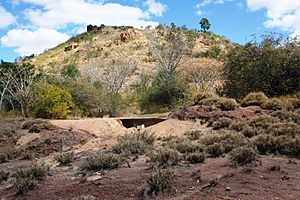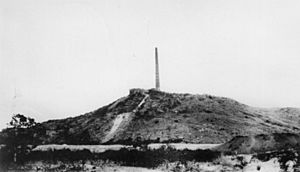Mining works on Towers Hill facts for kids
Quick facts for kids Mining works on Towers Hill |
|
|---|---|

Towers Hill, site of former mining activity, 2011
|
|
| Location | Towers Hill, Charters Towers, Charters Towers Region, Queensland, Australia |
| Design period | 1870s - 1890s (late 19th century) |
| Built | 1872 - 1940s |
| Official name: Towers Hill, Pyrites Works, Rainbow Battery, Towers Chlorination Works | |
| Type | state heritage (built, archaeological) |
| Designated | 29 April 2003 |
| Reference no. | 601851 |
| Significant period | 1872-1920s, 1940s (fabric, historical) |
| Significant components | pole/s - telephone, pole/s - telegraph, tailings dump, tank - reservoir, terracing, settling tank / pond, shaft, embankment - railway, magazine / explosives store, mullock heap, abutments - railway bridge, wall/s - retaining, mounting block/stand, dam/reservoir |
| Lua error in Module:Location_map at line 420: attempt to index field 'wikibase' (a nil value). | |
The Mining works on Towers Hill are a collection of old mining sites located on Towers Hill near Charters Towers in Queensland, Australia. These historic ruins show how gold was mined and processed a long time ago. They were built between 1872 and the 1940s.
The main parts of these works are known as the Pyrites Works, Rainbow Battery, and Towers Chlorination Works. They were officially added to the Queensland Heritage Register on April 29, 2003, because of their importance to Queensland's history.
Contents
Gold Mining History
Towers Hill is where gold was first found in December 1871. This discovery led to the creation of the Charters Towers Goldfield. A group of prospectors, including George E. Clarke, Hugh Mosman, John Fraser, and an Aboriginal man named Jupiter, made the find.
They set up camp near rocks that had quartz, which often contains gold. On March 25, 1872, the government officially gave Clarke, Mosman, and Fraser the rights to mine gold in that area.
Pyrites Works
By the mid-1880s, gold mining technology had greatly improved. In the early days, gold ore was crushed by heavy stamps. The resulting powder was then washed over copper plates coated with mercury to catch the gold. The gold was separated by heating the mercury.
However, this method didn't work well when miners dug deeper and found gold mixed with other minerals like pyrites (also called "fool's gold") and base metal sulphides. These minerals made it hard to get the gold out.
New processing plants were built to handle these difficult ores. These plants would concentrate the gold and then treat the leftover materials (called tailings). By 1878, there were six pyrites works in the Charters Towers Goldfield.
Chlorination Process
One new method was called chlorination, introduced in the mid-1880s. First, the concentrated ore was slowly roasted in a large furnace. This process removed sulphur and other metals that would interfere with the gold. Then, salt was added. Finally, chlorine gas and water were introduced. The gold would dissolve into a solution, which was then collected and processed to get the pure gold.
David Alexander Brown designed and built the first Pyrites Works. He even traveled to South Africa and England to learn about new methods. He was very impressed by new chemical and electrical techniques. When he returned, he built his special "Hillside" furnace and spent a lot of money on new equipment.
How the Works Operated
At the Pyrites Works, ore was fed in at the top of the hill. It moved down through a long furnace, which was over 100 metres (330 ft) long. Automatic tools moved the ore along the hearth, taking about three hours to reach the bottom.
A huge chimney stack, 54.7 metres (179 ft) tall, stood above the furnace. It was built from 120,000 bricks! Between the chimney and where the ore was fed in, there were special dust chambers. These chambers caught dust from the process.
The furnace itself had a total drop of 90.2 metres (296 ft) from top to bottom. The entire structure, from the furnace door to the top of the chimney, was 145 metres (476 ft) high. The furnace used a lot of wood to operate, processing about 250 to 300 tons of ore each week.
The company also installed electrical equipment. Motors hoisted ore up an inclined railway to the top of the hill. Other machines helped move dust, operate the furnace, and transport the ore.
Cyanide Treatment
The works also had large vats to dissolve gold from solutions. However, a new method called cyanide treatment became popular in Charters Towers around 1892. This new process was much simpler and cheaper. Because of this, the chlorination works, which had been very successful, eventually closed down.
By 1904, the Pyrites Works had changed to a cyanide treatment plant. They added more vats and started reprocessing the old red tailings using the cyanide method.
Rainbow Battery
The Rainbow reef was another important gold mining area in 1872. By mid-1875, a company was formed to dig a new deep shaft. The Rainbow mine produced a lot of gold, about 28,130 ounces (797,000 g), from 15,479 long tons (15,727 t) of ore. This mine operated until about 1896.
It's not clear exactly when the Rainbow battery (a type of crushing mill) was built. However, in 1897, a local newspaper reported that the Rainbow battery had a 16-horsepower engine and 10 stamp heads for crushing ore. Ore was brought directly to the mill. The battery was not in use in 1897 and was owned by the Queensland National Bank.
It's uncertain if the battery worked regularly after that, but it appears on maps from 1903 and later. In 1911, some miners treated ore from another mine at the Rainbow battery. A photo from 1917 shows the battery still standing, with its shed, tanks, and tailings dam.
Clarke's Mine and Battery
Clarke's mine is on the north-western side of Towers Hill. This is close to where George Clarke and his party first found gold in 1871. Clarke's Gold Mine worked on the Lady Maria and Moonstone reefs between 1872 and 1885.
In 1885, several mines joined together to form the Mosman Gold Mine. This larger mine operated until 1898. After that, the mines separated again, and Clarke's Gold Mine reopened in 1914. It was quite successful until 1924, producing about 42,000 ounces (1,200,000 g) of gold.
George Clarke later explored for gold in other areas, including Papua New Guinea, where he sadly died in 1895.
What Remains Today
Towers Hill is a large granite hill that rises 1,343 metres (4,406 ft) above sea level. You can still see many parts of the old mining operations there.
Pyrites Works Remains
The Pyrites Works site has many concrete, brick, and stone foundations from the old mill. These ruins stretch down the eastern side of Towers Hill. The remains of the huge brick chimney are on top of the hill.
You can also see the stone bases of two furnaces, which lead down from the chimney. The stone foundations of the chlorination works are located just south of the furnaces. Red piles of leftover material (tailings) from the Pyrites Works are at the base of the hill.
Further south, you can find the stone base of an original chimney and the path of the old Pyrites railway line, with stone supports for a bridge.
Rainbow Battery Remains
At the Rainbow Battery site, you can see concrete and stone foundations from the battery, as well as engine mounts and retaining walls. There's also a pit where tailings were stored and two large concrete tanks for settling. A stone and earth dam is next to the battery foundations.
Clarke's Mine and Battery Remains
At Clarke's mine, you can find the concrete and brick foundations for the winding engine, boiler, and headframe (the structure above the mine shaft). A large pile of waste rock (mullock) now covers the shaft entrance.
A concrete water tank was built on top of the hill overlooking the mine. You can also see the remains of a hut from World War II. During World War II, the mine's mullock pile was used to build four concrete storage buildings for explosives. These are part of a larger group of wartime structures on Towers Hill.
Old telegraph poles from the early telegraph route are also present, showing how communication lines once ran through the area.
Why Towers Hill is Important
The mining works on Towers Hill were listed on the Queensland Heritage Register on April 29, 2003. This means they are very important to Queensland's history and culture.
Shows How History Changed: The Pyrites Works site helps us understand how gold extraction methods changed over time in Queensland. Other parts of the site, like an old reservoir, telegraph poles, and World War II explosives stores, also show different parts of history. It's unique to see so many different historical layers in one place.
Rare and Special: The Pyrites Chlorination Works is a very rare example of its kind. It shows the latest chlorination technology before the cyanide process took over. It also shows how the plant was later changed to use the cyanide method.
Helps Us Learn More: These sites can teach us a lot about the history of mineral processing technology. Studying them helps experts understand how people used to get gold out of ore.
Shows Key Features: Towers Hill has the most complete remains of a pyrites chlorination works in Queensland. The Rainbow battery site is a good example of how ore processing mills were set up near gold reefs. Clarke's Mine and Battery show two different periods of mining in Charters Towers: the early discoveries and later deeper mining.
Looks Great: The Pyrites Chlorination works add to the historical look of Towers Hill. The large granite hill itself, rising 1,343 metres (4,406 ft) high, is a well-known landmark visible from far away.
Shows Clever Ideas: The Pyrites Chlorination Works shows how clever and advanced the technology was at that time. It's a rare example of the best chlorination process before new methods came along.
Important to the Community: Towers Hill is very important to the people of Charters Towers. It's a landmark that has been associated with the town since the 1870s, giving the area its nickname "The Towers."
Connected to Important People: Clarke's mine and battery foundations are significant because they are linked to George E. Clarke, one of the people who first discovered gold in the Charters Towers Goldfield.





